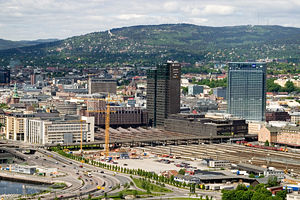Oslo East Station
|
Oslo Central Station
|
|
|---|---|
 |
|
| Location |
Jernbanetorget, Gamle Oslo, Oslo Norway |
| Coordinates | 59°54′40″N 10°45′3″E / 59.91111°N 10.75083°ECoordinates: 59°54′40″N 10°45′3″E / 59.91111°N 10.75083°E |
| Owned by | Rom Eiendom |
| Operated by |
Bane NOR Norwegian State Railways NSB Gjøvikbanen Airport Express Train SJ |
| Line(s) |
Drammen Line Vestfold Line Gardermoen Line Gjøvik Line Trunk Line Østfold Line |
| Connections |
Metro: Jernbanetorget (station) Tram: Bus: Oslo Bus Terminal |
| Construction | |
| Architect | John Engh |
| Other information | |
| Station code | IATA code: XZO |
| Fare zone | Ruter: 1 |
| Website | Official website (in Norwegian) |
| History | |
| Opened | 1987 |
Oslo Central Station (Norwegian: Oslo sentralstasjon, abbreviated Oslo S) is the main railway station in Oslo, and the largest railway station within the entire Norwegian railway system. It is the terminus of Drammen Line, Gardermoen Line, Gjøvik Line, Hoved Line and Østfold Line. It serves express, regional and local rail services by four companies. The railway station is owned by Rom Eiendom and operated by Bane NOR, and was opened in 1980.
Oslo Central was built on the site of the older Oslo East Station (Oslo Østbanestasjon, Oslo Ø), the combining of the former east and west stations being made possible by the opening of the Oslo Tunnel. Oslo Central has nineteen tracks, thirteen of which have connections through the Oslo Tunnel. The station has two buildings, the original Oslo East building and the newer main building for Oslo Central. Each building houses a large shopping centre. The square in front of the station is called Jernbanetorget.
When the first railway line, Hoved Line, was built between Oslo and Eidsvoll in 1854, the terminus in Oslo was constructed as an ad-hoc solution located at Gamlebyen. Alternate sites included Youngstorget, Grünerløkka and Vaterland Bridge. In 1852 an architectural competition was held, and a plan based on Crown Street Station in Liverpool won. The station was located east of the river Akerselva, but could not serve as a permanent solution, as it was close to neither the city centre nor the port. In 1859 the freight section of the station was expanded with the purchase of land between Loelva and the port, and part of Bjørvika. From the beginning, rail traffic increased, especially after the expansion of the Trunk Line to Hamar in 1862, and the opening of the Kongsvinger Line in 1865.
...
Wikipedia
